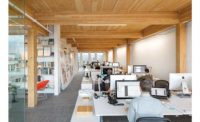In British Columbia’s capital regional district, where housing prices are among the least affordable in all of Canada, the municipality of Esquimalt has given the go-ahead to a development that will offer community-oriented, Passive House–certified, market-rate condominium housing at prices middle income households can contemplate. To achieve its affordability, sustainability, and liveability trifecta—garnering an associated height and density bonus from the municipality—the 83-unit, twelve-story development will combine prefabrication with mass-timber construction, topping out as one of the tallest wood buildings in North America.
“The goal is sustainable, attainable, liveable, community-oriented housing that empowers the end user,” says Oliver Lang, a principal at Vancouver-based Lang Wilson Practice in Architecture Culture (LWPAC), the project’s architect.
Located beside a naval base and named after a small, swift ship, Corvette Landing will consist of cross-laminated timber (CLT) wall, floor, and ceiling panels pre-fabricated to include electrical and plumbing services. These will be craned onto a site-cast concrete foundation comprising three levels of below-grade parking, then be bolted to an engineered wood frame. CLT-based modular cladding panels, which will arrive on-site complete with ten inches of insulation, windows, and a metal skin, will make the thermal envelope so tight the equivalent of a towel heater will heat an entire home.
The use of prefabrication is expected to lop ten months off the 26- to 28-month construction schedule that a comparable building in site-cast concrete would have needed. The carbon-sequestering wood structure will weigh about a quarter of its concrete equivalent, use less energy and produce fewer emissions in construction, and offer advantages in quality control, safety, and risk management through off-site construction. The faster, lower-cost prefabrication process (with the potential to replicate the approach across the portfolio of the developer, Standing Stone Developments), a 25 percent reduction in building size due to a corridor-free configuration, reduced operating costs, and design for hundred-year durability add up to “a value equation that’s very attractive,” says Lang.
Because the industry is still getting comfortable with mass-timber construction, the project is using panels rather than spatial modules (which would have increased efficiencies even further). And even though mass timber is not as susceptible to fire as stick framing, the timber panels will be encased in gypsum wallboard (and sprinklered) to facilitate regulators’ acceptance.
Winner of a 2017 LafargeHolcim Award, Corvette Landing stems from LWPAC’s decade-plus study of strategies for improving housing through streamlining the construction process. The project’s underlying paradigm, which LWPAC has branded Platforms for Life, uses specially developed design-to-fabrication software to explore multiple scenarios, provide feedback for livability, environmental performance, and critical project data, integrate engineering, and communicate directly with CNC and robotic fabrication equipment. “The platform challenges the conventions of how buildings have been delivered to date,” says Lang.






Post a comment to this article
Report Abusive Comment